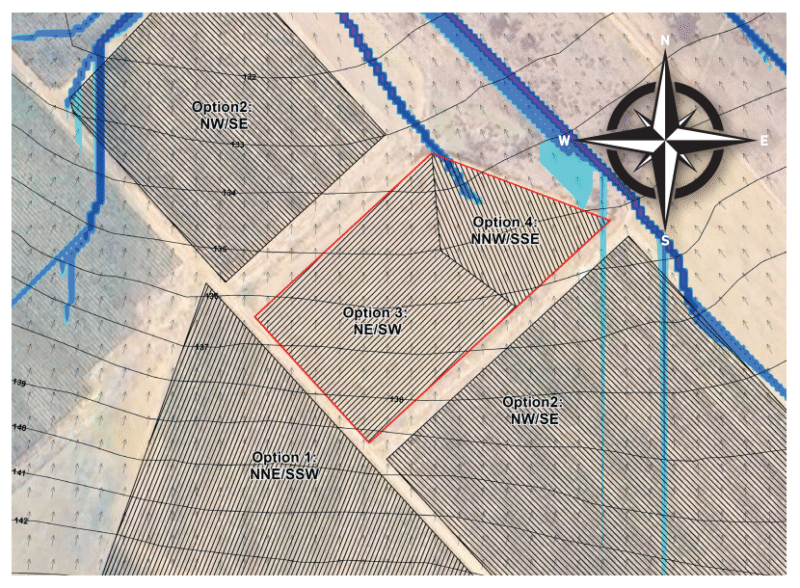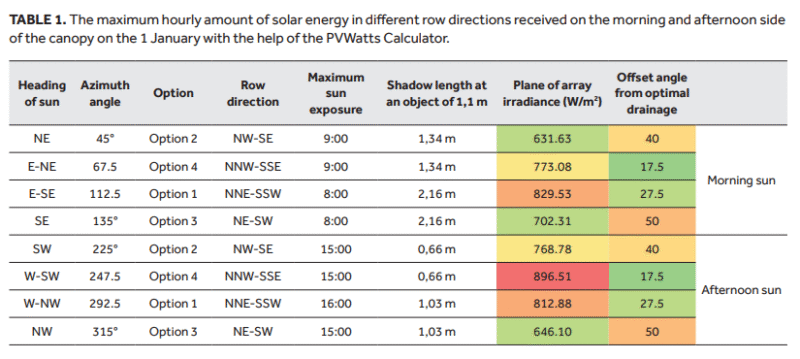Not long ago, our CEO popped into my office with a challenge: help figure out the best row direction for a new vineyard block for a top wine estate. The farm’s owner is a sharp, technical guy, so I knew I’d need to bring my best ideas – and be ready for a lively debate! His big worry? Sunburn on the grapes. He wanted a row direction to keep those berries safe from too much sun.
As a soil scientist, my first thought was drainage. This block sits on shallow, saline duplex soils, and picking the right row direction can make or break how well water moves off the surface. For these soils, the ideal direction is 5 degrees west of north – almost directly north-south. On the other hand, an east-west setup would be a disaster for drainage, running parallel to the contours and trapping subsurface and surface water. Practically and economically speaking, a northeast-southwest (NE-SW) direction would fit the block’s shape with longer rows. Still, it’s already 50 degrees off from the best drainage angle (with 90 degrees being the absolute worst).

FIGURE 1. The four options for row direction (NNE-SSW, NW-SE, NE-SW and NNW-SSE) and the direction of surface water runoff.
Plenty of research exists on vineyard row directions. The extensive work under local conditions by Kobus Hunter is a highly recommended read, but this isn’t about digging through studies. It’s about how I tackled this puzzle fast and built a solid case for the debate. Sunburn occurs when grapes get exposed to too much direct sunlight (measured in watts per square meter, W/m2). How bad it gets depends on the time of year, time of day, location, degree of cloudiness and hot weather. I’ll leave grape variety, berry growth stage, water stress and canopy details among the many factors to the viticulturists – those can be tweaked. Is solar energy hitting the grapes? That’s harder to dodge.
Here’s a fun way to think about it: a perfect VSP (vertical shoot-positioned) trellised vineyard is like a solar panel standing upright, soaking up the sun on both sides to produce sugar instead of electricity. That sparked an idea. I jumped onto the free PVWatts® Calculator online, a tool for sizing up solar panels. It turned out to be an excellent fit for comparing row directions. You just type in your location (start with the nearest town, then zoom to your vineyard), leave most settings as they are, and tweak two key things: the tilt (90 degrees for a VSP) and the azimuth heading (the angle, clockwise from true north, that your rows are orientated).
Below is a table showing how azimuth ties to row direction – and which rows get slammed with the most hourly sunlight.

The results? The best drainage direction (NNW-SSE, option 4) also gets the most afternoon sun, but this is bad news for sunburn. The NE-SW (option 3) direction receives the least sun, but is terrible for drainage. Knowing how much these soils are prone to stagnant water, I could only stomach two options: NNE-SSW (option 1) or NNW-SSE (option 4). NNE-SSW (option 1) edged out as my pick – it’s a bit cooler and more balanced across the block.
Then there’s the wind. Summer here is synonymous with a strong southeast breeze, especially in the afternoons. I chatted with the farm’s seasoned viticulturist while we stood in the vineyard, and he dropped some wisdom: the NNE-SSW (option 1) rows on the farm have less sunburn than the NW-SE (option 2) ones. Why? That southeasterly wind bends the top part of the canopy (free-hanging above the top foliage wire) to the northwest. In NW-SE rows, the wind blows along the rows, and the canopy “fringe” lines up with the row direction, leaving grapes more exposed. But in NNE-SSW rows, the “fringe” shoots sprawl across the afternoon sun side, casting a shadow that shields the grapes on the opposite rows from the harshest rays.
The maximum morning sun exposure for NNE-SSW (08:00) will also be limited if the row width is less than 2,16 m, caused by the low angle of the sun and the shadow that will be cast by a 1,1 m-high canopy in relation to the grapes. The SunCalc.org website was used to determine the shadow length.
So, there you have it – science, soil, sun and a bit of wind all mixed into one decision. NNE-SSW feels like the sweet spot for this block. Now, I’m ready for that debate!
For more information, contact Heinrich Schloms at heinrich@vinpro.co.za.
Click here to get your copy of WineLand Magazine.













